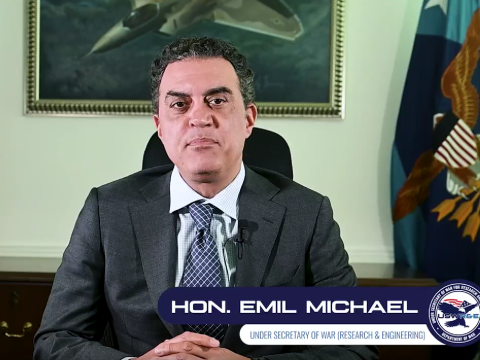Novel DoD Group Working on Cementing Its Place
Associates with the Transition Tracking Action Group (TTAG) are identifying several improvements they want to make to assist the federal government and military more effectively and efficiently. The group has already proven to help military operations in many ways, even though it is new and in the early stages of development. But now, team members are looking to the future of the group, and they are seeing ways to take their services to the next level.
Firstly, group members want to integrate their implementation plan, which was approved and signed late last year by the secretary of defense, according to Cyrus Jabbari, chief data officer to the undersecretary of defense for Research and Engineering. Once put into effect, the implementation plan “would set a preliminary set of recommended actions that, at an enterprise level, the Department of Defense (DoD) is supposed to go and enact in subsequent years to create a no-kidding, robust, common data model that allows for tracking technology transitions across the research, development, acquisition life cycle,” Jabbari said in an interview with SIGNAL Media.
This development is monumental within the DoD, Jabbari stressed. With the implementation plan approved and ready to go, DoD leaders can now take the TTAG’s findings and use them to help make their operations easier.
“Now all DoD components at the highest level—you’re talking about the DoD chief financial officer; the comptroller; the chief digital and artificial intelligence office; the secretaries of the Army, Navy, Air Force and so forth—they’re all tasked to go and implement these recommended actions to build that common data model, which would allow for a lot of great artificial intelligence and machine learning techniques and possibly some other AI techniques to be applied to this more robust, clean, large data set,” Jabbari said.
One of the group’s main goals is that team members and machine learning tools comb through and inspect DoD investments. The goal of this process is to ensure funds are put toward priority areas rather than wasting valuable resources. To accomplish this more effectively, group officials want to create a common taxonomy-type classification chart that allows the entire DoD to recommend which technology areas they want to prioritize when it comes to making investments.
“To define a taxonomy is a huge deal for any data analytics effort because that’s essentially your rubric or your dictionary for how you’re going to start tagging data, and that’s hard for any organization,” Jabbari said. “So, to do that at the department level will be a monumental feat.”
“We now have directed action to do it,” Jabbari added. “Once we do that, the actual tagging and getting the data to talk to each other is rather simple. I don’t want to trivialize it too much, but I think there’s a lot that we’ll accomplish with the execution of the TTAG implementation plan over the next two years.”
Additionally, team personnel are planning to create a new data fabric that will help on the technological side of a novel capability process proposal being developed by the TTAG in conjunction with several groups within the DoD, including the Joint Staff, undersecretary of defense for Acquisition and Sustainment and undersecretary of defense for Research and Engineering. Under this proposal, the Joint Staff monitors and records all requirements given by the combatant commands.
Next, the undersecretary of defense for Acquisition and Sustainment is responsible for integrating portfolios that include information regarding which capabilities the DoD is acquiring and which capabilities the DoD is planning to sustain, according to Jabbari.
Lastly, the undersecretary of defense for Research and Engineering and other innovative offices then decide what short- and long-term technologies and innovations need to be developed to fulfill those requirements handed down by the combatant commands and warfighters, according to Jabbari. This is where the TTAG comes into play.
“We’re making sure that we’re piloting our efforts with our partners in acquisition and sustainment, in the Joint Staff, the services and combatant commands, so that we could build a capability that also links these technologies to what’s being asked for directly by the warfighter,” Jabbari said.
Officials are already using their unprecedented DoD-wide analytic capability to quickly sift through investment data to analyze the effectiveness of those ventures. DoD leaders can now track each investment, big or small, in seconds, according to Jabbari.
“For the first time ever, we could see, within seconds, how, on an annual basis, each dollar of the $145 billion that are vested to us by Congress or appropriated to us by Congress, how we invest that in ways like by congressional district, by the critical technology area that we prioritize, by the executing entity, by the performer, by the contract type or the award type,” Jabbari explained. “And what that translates to is not just those acute insights, but actually the more impact.”
The DoD chartered the TTAG in February 2024 with several goals in mind, one of which was expediting and cleansing the data transfer process. This allows personnel around the military, including warfighters, to be better informed more quickly, a crucial component when it comes to keeping the troops safe and prepared. Additionally, creating a more effective and efficient tracking network that speeds the flow of data will also enable military leaders to easily see which capabilities are succeeding or failing and which technologies or ideas they still need to help improve their operations, according to Jabbari. This accelerated process will help officials in the private sector understand what has worked and not worked in the past and what technological areas they still need to tackle. The TTAG’s efforts would ideally give rise to more advanced developments in the technology industry.
The American people will also become beneficiaries of the group’s services. Its efforts would help guide the DoD to spend the taxpayers’ money more wisely and in areas of need. By using this process, the DoD will save millions and possibly billions of dollars, and DoD officials will be able to execute their duties more efficiently, according to Jabbari. Furthermore, better communication and more advanced technology being developed quicker would ideally lead to a safer country.
Moreover, the TTAG was created to track the technology development process, from the contracting stage to the prototyping stage and finally to the point when warfighters can utilize the tool in action. This could lead to more transparency and better communication between DoD leaders and the private sector, saving each party time and money, according to DoD officials.
Despite these successes and all the potential the group and its members are showing, they have encountered a couple of challenges. Firstly, convincing people to learn and become familiar with an entirely new system is not easy. Instead of transferring over to this new model, people will want to stay close to the process they know, so encouraging them, getting people to make the move and training them will be difficult, Jabbari predicted.
Additionally, the more data compiled in one place means the more likely it will be subjected to attacks by adversaries, especially when it is related to the DoD, Jabbari warned. So, crews behind the scenes will be tasked with protecting the database from risks and threats to keep the information safe and secure.
As aforementioned, the TTAG is a relatively new group, but since the team is already showing promise and potential, those involved are excited about what they have achieved so far, and they are looking forward to what the future holds.
“TTAG has been a monumental feat, because in just one year, we’ve accomplished so much that’s received, fortunately, funding across DoD components from the undersecretary of defense within a budget cycle,” Jabbari said. “That’s a huge, huge feat. Making this a more enduring capability to serve—DoD stakeholders as well as Congress and the public—is probably a longer-term priority that we want to make sure that we set ourselves up for success.”




Comments